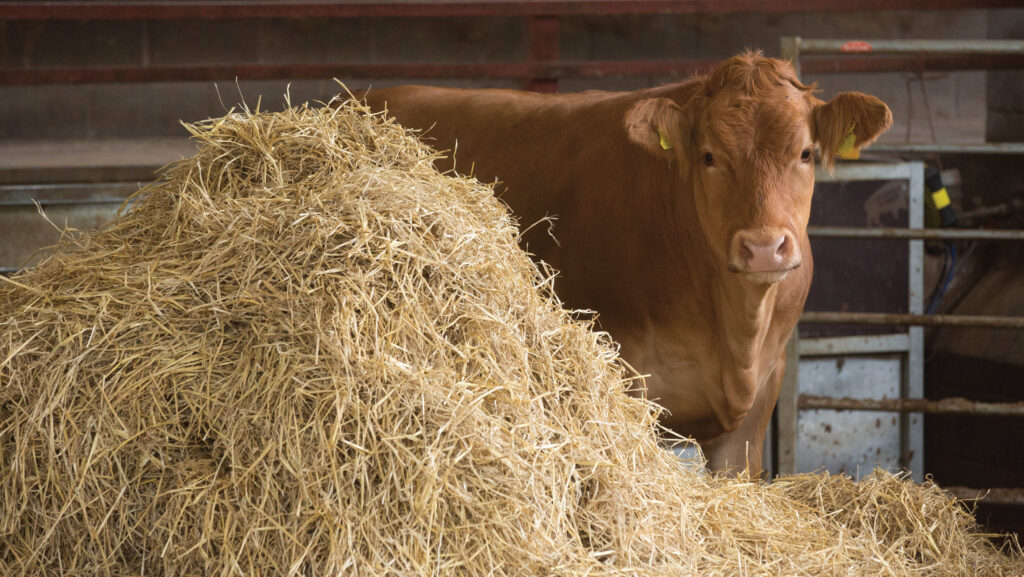Why it’s important to plan winter bedding now
 © Tim Scrivener
© Tim Scrivener For farmers reliant on purchased straw to bed loose-housed cattle, now is the time to consider other options and have a “Plan B” in place to reduce winter bedding costs.
In Great Britain, big-baled barley straw was averaging £97/t (ex-farm) and big-baled wheat straw £91/t (ex-farm) for the week ending 9 June, according to figures from the British Hay and Straw Merchants Association.
See also: Cost-focused Angus herd targets further £8 a cow savings
Independent beef and sheep consultant Emily Grant of Forrit consultancy says this represents an increase of approximately £48/t for both commodities.
“For suckler producers, that can be quite a significant cost in wintering,” she points out.
AHDB’s Early Bird Survey in March, predicted the overall wheat area for the 2024 harvest would fall 15%, while low winter barley planting would be offset by intentions to sow more in the spring.
Final estimates of the 2024 harvest are not available until the end of June.
If the total planting area is down, it will be unwelcome news for many cattle farmers already low on straw stocks, having endured a long winter housing period caused by the soggy start to spring, says Emily.
Here, she gives advice for outwintering stock – see “Bedding options compared” for alternative bedding materials.
Bale grazing
Bale grazing is growing in popularity on Scottish farms, says Emily. This involves arranging hay bales in a field and building grass covers for winter grazing.
Grass is then strip-grazed using an electric fence, with cattle moved daily.
“It requires planning and [grazing] infrastructure, but the labour and housing cost savings are worth it,” she says.
Fields are shut off in July, depending on farm location and pasture type, with bales then placed in-situ soon afterwards.
Field selection is important: ideally, they should be free-draining and sheltered for stock in case weather conditions turn. In comparison to a forage crop, the grass offers good soil protection, adds Emily.
Another cost advantage, she says, is that bales are only handled once when they are set out during the summer when ground conditions are good, plus manure doesn’t need to be handled and spread.
“Hay doesn’t need to be protected. Most people doing it find 5-10% wastage at worst.
“Some farmers use silage bales, but this requires ring feeders because [of] higher wastage,” says Emily adding that ring feeders can be cumbersome to move and roll onto the next bale.
Bale grazing provides the perfect winter ration for spring-calving suckler cows.
“The nutritional requirements of suckler cows are not high during the winter, plus deferred grass quality isn’t too bad, so hay is a good balance,” she explains.
She adds that deferred grass tested in late December can have a nutritional quality of 9.5MJ of metabolisable energy (ME) and 14.8% crude protein (CP), which can provide a good balance to hay at 8.2MJ of ME and 9.5% CP.
Furthermore, Emily points out that, unlike brassicas, bale grazing doesn’t require the field to be sprayed off, cultivated or reseeded and stock don’t require transitioning.
Outwintering on brassica crops
Another option for outwintering is to establish forage brassicas.
These will typically offer higher quality and quantity of feed, so they can suit youngstock well, but they are riskier in terms of weather.
“They require dry weather conditions during establishment and winter hardiness. Plus, the hardier brassicas like kale and swedes ideally need to be in the ground by mid-June.”
However, they are a good break crop and there is still time for farmers to sow some brassicas – rape and rape/kale hybrids can be planted as late as August, she advises.
“Fast-growing hybrids also offer an opportunity for two grazings between sowing and the winter,” she adds.
Straw alternatives
For farmers unable to consider fully outwintering due to farm location, land type and higher rainfall, Emily advises costing alternative bedding options now.
“You need to consider how much you need and, if the material is not particularly absorbent, you may need more of it [so it may not be as cost-effective as you think]. Do your homework now and have a Plan B.”
Bedding options compared |
||||
|
Bedding material |
Cost |
Absorbency |
Pros |
Cons |
|
Straw |
£94/t (ex-farm) |
Good – moisture content of 15-20%
|
Provides high-quality fertiliser in the form of farmyard manure
|
|
|
Woodchip |
£38-£50/t plus VAT, including delivery |
Low, although free-draining
|
No dust and low risk of mould growth
|
|
|
Sawdust and shavings |
£52-£175/t plus VAT, including delivery
|
Moderate – requires changing regularly |
Damp sawdust can harbour mould spores |
|
|
Sand |
£15-£20/t plus VAT, including delivery |
Low – can become compacted with pools of urine/faeces settling on the surface |
|
|
| Sources: Farm Advisory Service, AHDB. The price ranges are based on quotes from AW Jenkinson Woodwaste, Bodens Group, Platts and dairy farmers buying sand; supplied on 11 June. | ||||
